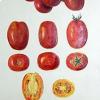L’antico ortaggio dal nome regale Re Umberto è un pomodoro che risale al XIX secolo, noto anche come Fiascone. Ma perché si chiama Re Umberto? Si racconta che sia stato un omaggio a Umberto I di Savoia, quando da Re d’Italia visitò Napoli per la prima volta nel 1878. Ed ecco quindi che non si può non associarlo anche alla pizza margherita: è il pomodoro che in effetti ha “regalato” al mondo questo felice connubio (il pomodoro è l’elemento quasi sempre immancabile per una buona pizza). E in effetti è un’eccellente varietà di pomodoro da sugo o conserva che ha dato origine al pomodoro San Marzano. E’ stato coltivato in Italia per oltre un secolo e venduto da tutte le maggiori ditte sementiere.
I cataloghi della ditta Sgaravatti che vanno dal 1910 al 1940, lo descrivevano come un “must”: era considerato un pomodoro d’eccellenza, per il suo sapore intenso, per la produzione molto generosa grazie a piante vigorose.
Ma i suoi semi vennero confusi e mischiati con altre varietà, e divenne sempre più difficile reperirlo anche a causa della cancellazione dal registro delle varietà da parte dell’Ense (all’epoca, Ente incaricato del controllo ufficiale delle sementi). Eppure è uno dei pochi pomodori nazionali che a quei tempi era apprezzato e coltivato in molte parti del mondo.
Il Re Umberto venne citato dalla storica società francese Vilmorin-Andrieux (nacque nel XVIII secolo e contribuì alla conoscenza botanica e agronomica) e nel famoso libro “The Vegetable Garden“, oltre a illustrarlo, lo definisce di forma ovale ma appiattita sui lati, che cresce in grappoli da 5 a 10 pomodori. Anche l’Istituto di Agronomia Generale e Coltivazioni Erbacee dell’Università degli Studi di Napoli ne fece eseguire illustrazioni ora conservate presso il Museo della Reggia di Portici.
A Tramonti, in Costiera amalfitana, iniziò ad essere coltivato nei primi anni del ‘900, e i suoi semi vennero diffusi di mano in mano in tutte le tredici contrade. Ogni famiglia aveva il suo terreno usato per la coltivazione di questo pomodoro, ed ogni estate, dopo la raccolta che avveniva con la giusta maturazione, e di mattina presto, si provvedeva a fare la conserva di pomodori. Prodotto che non doveva mai mancare in una casa e che durava per tutto l’anno.
Ma, anche qui ha subìto negli anni il declino, soppiantato da altre varietà, fino a quasi perderne la memoria, se non fosse stato per alcuni contadini locali che gelosamente l’hanno custodito e donato all’Associazione Acarbio, così da distribuirlo a quanti hanno a cuore la biodiversità rurale dell’area e avviare così un nuovo percorso legato alla tradizione grazie anche ad un progetto di crowdfunding.
E così sono stati messi in rete i contadini, distribuiti i semi, seguiti nella fase della crescita delle piantine e nella raccolta, con l’aiuto di esperti agronomi del Crea Ort di Pontecagnano e con il contributo del Comitato Promotore dei Distretti Rurali.
Questa varietà di pomodoro ancora oggi è considerata rara e conservata da alcuni “Seed Savers” (“conservatori di semi”) di diversi Paesi del mondo.

King Umberto tomato is an ancient species that dates back from the 19th century. The story tells that the name is a tribute to the Umberto I of Savoy as he was the King of Italy during his first visit to Naples in 1878.
Famous catalogues from Sgaravatti Company having been published from 1910 to 1940 considered this tomato species as a must. It is considered a species of excellence due to its intense flavour and tremendous output, thanks to healthy plants.
Unfortunately, the seeds are usually confused and mixed with another species, and they have been more and more difficult to be found due to the removal from the biodiversity register of Ense (the official body with the responsibility for controlling seeds at the time). Yet it was one of the few national tomatoes that were appreciated and grown in many parts of the world.
The King Umberto tomato was defined in the famous book 'The Vegetable Garden' by the historic French company Vilmorin-Andrieux (which was founded in the 18th century and well-known for the contribution of botany and agronomy knowledge) to have an oval shape but are flat on the sides, and grows in bunches from 5 to 10 tomatoes. In addition, the Institute of “Agronomia Generale” and “Coltivazioni erbacee”, University of Naples has performed many illustrations and they are now displayed at the Museum of the Royal Palace in Portici.
In Tramonti, Amalfi Coast, the tomato has been cultivated since the 1900s, and the seeds were spread to all 13 villages by hand. Each household had its own land used for growing this tomato, and every summer when the tomatoes reached their peak of ripeness, the farmers harvested and put them in glass jars (the term 'Fare le bottiglie' is still used nowadays, which literally means 'Do the bottles'). The products could be found in every family throughout the year. They were used to make a number of traditional dishes.
However, here in Tramonti, we have faced the decline in production over the years, mainly because of the replacement of other species. The tomato is almost forgotten, if it was not the local farmers who have guarded and donated the seeds to Acarbio in order to distribute them to those who have interest in biodiversity of the country and to start a new chapter in the tradition.
The history of the King Umberto tomato is not only symbolic but it also helps people understand without biodiversity 'guardians', many species would become extinct.
Today the King Umberto is considered a rare tomato species and preserved by some 'Seed Savers' from different countries around the world.










